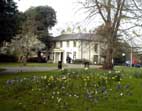
A Walthamstow extension Walk
Route & what to see
|
|
| london-footprints.co.uk |
This 3 mile linear walk can be done as an extension to the Walthamstow village route or on its own. It finishes at Stamford Hill (national rail or buses).
Begin at Walthamstow Central
Station (National Rail or Victoria line).
The station, opened by the Great Eastern Railway in 1870,
was originally called Hoe Street. The Victoria line was extended
to Walthamstow in 1968.
Exit via the bus station and
go left along the High Street
This has the longest street market in London. The library,
designed by J W Dunford and financed by Andrew Carnegie was built
in 1907-9. The Chequers is a late Georgian building. Manze's shop
(number 76) has attractive premises.
Return and go left at
Mission Grove
The school at the end was built in 1906.
Continue to the left
On the left is the former Dominion Cinema which was opened in
1930 and replaced the Prince's Pavilion. It closed as a cinema in
1961 and was on bingo until 1996. Detour into Buxton Road to view
the derelict frontage. Opposite a small car park is Clock House
(1813) a family home of the Warners who developed the surrounding
area from the 1880s.
Return to the High Street
via Pretoria Avenue
These are Warner houses. In the High Street are Art Deco premises
which were built for Montagu Burton in 1935. They retain their
billard halls on the upper floor. The shops opposite were built
in 1900.
Cross St James's Street and
go along Leucha Road.
The cottage flats in this road, which is now a conservation area,
were built in 1895.
At the end of the road go
left along Coppermill Lane.
This follows the line of a track known as Marsh Street which
linked Walthamstow village with the marsh and mill. Beyond the
houses the lane crosses a flood relief channel. Just past this
are Thames Waterworks with reservoirs to the right and treatment
works to the left. Buildings of Docklands and the City can be
seen beyond these. At Gate 4 there is a view of the old copper
mill. The site has been used for milling since the 14th century
dealing with corn, gunpowder, paper, leather and linseed. In 1806
the buildings were sold to the British Copper Company and
switched to the making of coin tokens, employing a number of
local people. Production ceased in 1857 and the machinery was
taken to Swansea. It was taken over by the East London Waterworks
in 1860 and the tower was added in 1864 to house a steam engine.
The Coppermill Stream runs alongside the path from this point.
Pass under the railway and
at Coppermill Bridge bear right across the stream.
A loop in the River Lea provides a location for Springfield
Marina.
Cross over the footbridge
and enter Springfield Park on the left.
The gardens of 3 early 19th century houses were made into a
public park in 1905. One has been retained and provides
refreshment facilities. There are maps at the park entrances and
information boards.
When you have explored the
park exit at the north west gate and go left up Spring Hill.
Cross Clapton Common to the church.
St Thomas's was a proprietary chapel built with the neighbouring
terrace in 1774. The tower was added in 1829 and the building
repaired after war damage by Cachemaille-Day. It has heraldic
stained glass by Goddard & Gibbs.
Continue along the terrace
then Clapton Common
The Swan replaced a coaching inn named the White Swan.
Cross to the pond and go to
the far side of this. Bear left to the prominent church.
This was designed by Joseph Morris for the Agapemonite sect in
1892-5. It features large stone sculptures by A G Walters
representing the four evangalists, repeated as bronze figures at
the base of the spire. It has stained glass designed by Walter
Crane in 1896. The sect left in the 1920s and since 1956 it has
been an Ancient Catholic Church 'The Church of the Good
Shepherd'.
Left into Egerton Road
The New Synagogue was built in 1914-5 to replace the one in Great
St Helens. The design was based on this building and included
some of its fixtures.
Continue to the end of the road. Stamford Hill Station can be accessed along Amhurst Park or Stamford Hill is on several bus routes.
london-footprints.co.uk 2012
Resources
Buildings of England London 4: North by Cherry & Pevsner
Walthamstow Marsh - a guide to the history of the area produced
by Lee Valley Park Authority